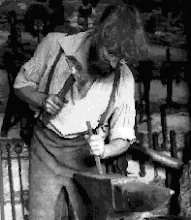
The system uses a thin ceramic plate that covers the part of the furnace around the tuyere that is subjected to the highest temperatures. The thin plate is intended to radiate off heat and thus resist melting. There is no actual tuyere, instead the air is applied through a tube that sits some distance away from, yet aimed at, the blow hole in the plate. In effect the rapidly moving air blast creates a venturi effect which draws in considerably more air than is provided via the air pump itself.
This effect was quite noticeable. It should be considered when looking at the raw numbers below, as these are a measure of the air inside the tube itself. There would have been considerably more air available on the inside of the furnace.
(I have removed the table I posted up here previously - as I realized this morning I had made a major error on how I interpreted the data, and thus crunched the numbers. Expect a corrected version with comments the first week in April.)








No comments:
Post a Comment